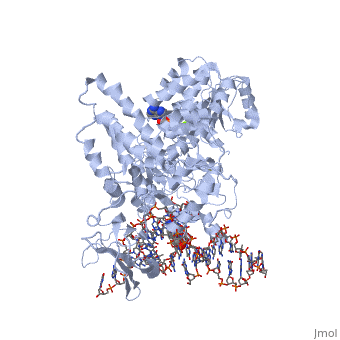1gm5
From Proteopedia
Structure of RecG bound to three-way DNA junction
Structural highlights
FunctionEvolutionary ConservationCheck, as determined by ConSurfDB. You may read the explanation of the method and the full data available from ConSurf. Publication Abstract from PubMedThe stalling of DNA replication forks that occurs as a consequence of encountering DNA damage is a critical problem for cells. RecG protein is involved in the processing of stalled replication forks, and acts by reversing the fork past the damage to create a four-way junction that allows template switching and lesion bypass. We have determined the crystal structure of RecG bound to a DNA substrate that mimics a stalled replication fork. The structure not only reveals the elegant mechanism used by the protein to recognize junctions but has also trapped the protein in the initial stage of fork reversal. We propose a mechanism for how forks are processed by RecG to facilitate replication fork restart. In addition, this structure suggests that the mechanism and function of the two largest helicase superfamilies are distinct. Structural analysis of DNA replication fork reversal by RecG.,Singleton MR, Scaife S, Wigley DB Cell. 2001 Oct 5;107(1):79-89. PMID:11595187[1] From MEDLINE®/PubMed®, a database of the U.S. National Library of Medicine. See AlsoReferences
| ||||||||||||||||||||


